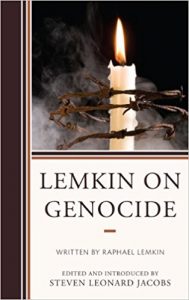Special for the Armenian Weekly
Dr. Steven Leonard Jacobs holds the Aaron Aronov Endowed Chair of Judaic Studies and is Associate Professor of Religious Studies at the University of Alabama-Tuscaloosa. An ordained rabbi, Professor Jacobs is a specialist on the Holocaust and Genocide, Biblical Studies, Jewish-Christian Relations, and is one of the foremost authorities on Raphael Lemkin (1900-1959), who coined the term “genocide” and devoted his life to the enactment of an international law on the punishment and prevention of genocide.
Among his numerous publications, he is the author of the chapter entitled, “Lemkin on Three Genocides: Comparing His Writings on the Armenian, Assyrian, and Greek Genocides,” in the recently published book, Genocide in the Ottoman Empire: Armenians, Assyrians, and Greeks 1913-1923, edited by George N. Shirinian (New York and Oxford: Berghahn Books, 2017, published in association with The Asia Minor and Pontos Hellenic Research Center and The Zoryan Institute).
The interview was conducted by e-mail during the middle of May 2017.
***
George Shirinian: Your unique contribution to this new book is a comparative study of the writings of Raphael Lemkin on the Armenian, Assyrian, and Greek Genocides. Who was Raphael Lemkin, and why is what he wrote important?
Steven L. Jacobs: Lemkin (1900-1959) was a Polish-Jewish lawyer who emigrated to the United States after the Nazi invasion of Poland in 1939. His initial concerns during his teenage years with the gross inhumanity of groups of people in power towards other groups having little or none led him to a concern with international criminal law. After arriving in the US, he taught law at both Duke University and Yale University before joining the US Board of Economic Advisors in Washington, DC, and would later serve as an advisor to Justice Robert H. Jackson during the post-WWII International Military Tribunal at Nuremburg, Germany, dealing with Nazi war criminals. He would devote the remaining thirteen years of his life to seeking the ultimately-successful ratification of the Convention on the Prevention and Punishment of the Crime of Genocide by the United Nations in December 1948. His coinage of the word “genocide” appeared in his magnum opus Axis Rule in Occupied Europe: Laws of Occupation, Analysis of Government, Proposals for Redress (Washington, DC: Carnegie Endowment for International Peace, 1944), specifically Chapter 9 (pgs. 79-94). It is somewhat ironic that this small chapter in this massive volume of almost 650 pages became his life’s work.
His voluminous writings, and even a television appearance, on the subject of genocide brought the concept of mega-group murder to the attention of the world community of scholars, intellectuals, and the wider public, and began a debate about its various permutations and configurations which continues to this day. All this affirms him as the “Father of Genocide Studies,” an outgrowth and expansion of the field of Holocaust Studies.
G.S.: Lemkin wrote at a time when the study of the Ottoman destruction of the Armenians, Assyrians, and Greeks was in its infancy. What sources did he use? Did he say anything that historians today find useful?
S.L.J.: In addition to his 1944 text, Axis Rule in Occupied Europe, Lemkin also intended to publish a three-volume History of Genocide (Antiquity, Middle Ages, Modern Times), as well as a monograph, Introduction to the Study of Genocide. Neither was completed nor published. In 2012, it was my good fortune to edit, introduce, and bring to publication both sets of texts, even though incomplete, in one volume, titled Lemkin on Genocide (Lanham, Md.: Lexington Books).
As to his use of sources, it is important to keep in mind that Lemkin was a master of many languages—Polish, Russian, French, German, Hebrew, Yiddish (and others!)—and was thus able to draw upon numerous publications in those languages which addressed the thirteen genocides included. Most of the sixty-three genocides reflected in his Outline were never addressed. An in-depth examination of more than 20,000 pages of his archives only barely hints at these other texts.
Lemkin left a substantial, untitled, 120-page monograph on the Armenian Genocide, along with a six-page summary, and the monograph has been published (Raphael Lemkin’s Dossier on the Armenian Genocide, Glendale, Calif.: Center for Armenian Remembrance, 2008). I have written several articles about Lemkin and the Armenian Genocide.
As regards the Assyrian Genocide, not one but two chapters—Chapter 2 (“Assyrian Invasions”) of Volume I, and Chapter 2 (“Assyrians in Iraq”) of Volume III—are included among his papers. The latter constitutes a forty-two-page chapter in Lemkin on Genocide.
Most interesting of all, however, with regard to the Greek Genocide, five chapters are presented in the outline, more than any other case. These are titled, “Genocide in Ancient Greece”, “Genocide against the Greeks,” “Greeks under Franks, “Greeks in Exile from Turkish Occupation,” and “Genocide by the Greeks against the Turks.” Unfortunately, none of these is found among his papers. Instead, what we do have are a large text of so-called “Background” of fifty-seven pages and a later edited and slightly smaller version (fifty-five pages) entitled “Greeks in the Ottoman Empire,” the title of which is not listed in the outline. Three additional chapters in Volume III—“Bulgaria under the Turks,” “Genocide by the Janissaries,” and “Smyrna”—would have proven most helpful regarding his thinking about both the Ottoman Empire and the post-Ottoman Kemalist regime. But, alas, they, too, are not found among his papers, and, in all likelihood, were never written. One chapter that does exist is on the massacre of Greeks in Chios during the Greek War of Independence. It constitutes six pages in Lemkin on Genocide. I have also written separately on Lemkin and the Genocide of the Greeks.
To historians today, not only are his bibliographies of value in visiting the various genocides he examined, but his historical summaries, comments and critiques regarding victims, perpetrators, and bystanders enlarge the work beyond simply that of reporting the past. Moreover, Lemkin broadened his concerns to include the arenas of morality, ethics, and practical and political responsibilities, with which we continually wrestle today.
G.S.: Your new article deals with Lemkin’s writings on three cases of genocide. What benefits are there, generally, to taking a comparative approach?
S.L.J.: In principle, comparative work begins with an open mind: bringing together two or more seemingly disparate cases, events, or people and looking not only for similarities but differences as well, and then expanding the search to include other scenarios as well. What can, ideally, result is a broadened perspective and understanding regarding those items under examination, and, further, their possible applicability as additional case studies are brought into the conversation.
It is important to keep in mind that comparison is not the only tool that scholars bring to the table. Vetting historical documents, knowledge of specific languages and how they were understood at the time of their use, interviewing witnesses to contemporary events (and vetting the accuracy of their memories) are also used to ascertain the most accurate and complete pictures of those things under investigation. All tools used by various disciplines in the “human sciences” (history, literature, psychology, sociology, religious & Judaic studies, etc.) have, over the generations, proven their value in examining the past, and even going so far as to proving their applicability to both the present and the future.
G.S.: In this specific case of Raphael Lemkin, what has a comparative approach revealed?
S.L.J.: A. Strictly speaking, Lemkin was not a comparativist. He was of that “first” generation of historians, writers, and thinkers who saw as his task to “get the word out,” that is to say, present the evidence of those cases of genocide that were of importance to him—together with his own commentaries—and then let others expand the cases and draw further conclusions. His “mission,” if you will, was to get the world—at least the Western world—to view group murder in a whole new way, based on the reality that genocide has, historically, always been part of the human journey. His objective was to make others realize that it was not only the present moment (World War II and the Nazi murder of the Jews and its initial aftermath) that were genocidal, but, throughout human history, human power groups have engaged in genocide against non-power groups for a whole host of reasons (political, social, religious, economic, etc.). In doing so, Lemkin opened the door to this “darker side” of human history, and for that he is to be applauded.
Additionally, it must also be noted that Lemkin was not a classically-trained historian, but, rather, a lawyer who saw his stage as that of international law. Scholar that he was, he filtered his work through the lens of its practical applicability, understanding law and its prosecutorial opportunities as the appropriate arena where past crimes could be evaluated, current perpetrators could be punished, and, ideally, future cases of genocide could be prevented.
G.S.: Lemkin is famous for coining the word “genocide” and providing the first comprehensive definition of it. Did he doubt that the term applies equally to the Armenians, Assyrians, and Greeks?
S.L.J.: Most assuredly, he understood these three cases as genocide. Today, there are three sources of denial that they are genocide. One originates with the inheritor of the perpetrator Ottoman state, which seeks to evade any responsibility for past crimes, and those who support it for political or economic reasons. The second originates from what sociologists call “the competition of victims.” This refers to the tendency of some victim groups to want to make their genocide seem more important by denying status to others. The third originates with some genocide scholars, who are so caught up in narrowly defining what genocide is, that they lose sight of the impact on the survivors and their descendants.
It is part of the work of scholars to define and categorize the events they/we study, and to expand and/or contract these same definitions, further refining similarities and differences, as they/we apply them to specific case studies. In the process, however, we must never lose sight of our humanity.
G.S.: Is there any reason for anyone today to doubt that the term applies equally to the Armenians, Assyrians, and Greeks?
S.L.J.: Not at all. My contribution to Genocide in the Ottoman Empire was to examine in depth, perhaps for the first time, Lemkin’s writings on these three genocides—Armenian, Assyrian, and Greek—what he wrote, what he saw as their similarities and differences, and fault not only the Turks but the Germans and British, as well, as uneven partners in these crimes. Certainly, Lemkin saw parallels between genocide in the Ottoman Empire and that in Nazi Germany.




